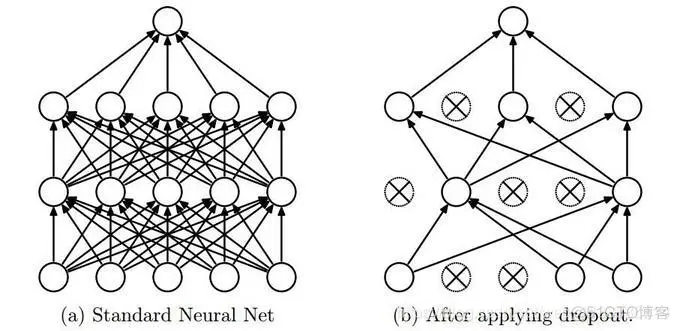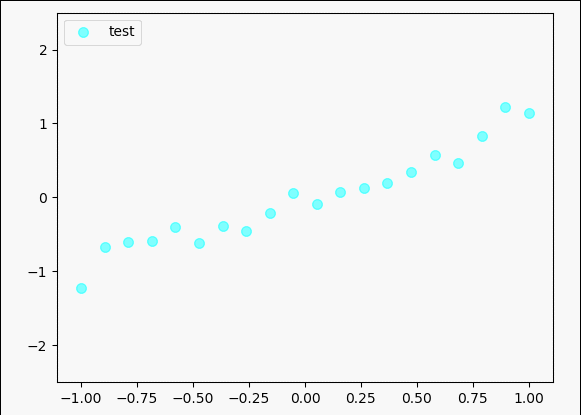产品
开篇明义,dropout是指在深度学习网络的训练过程中,对于神经网络单元,按照一定的概率将其暂时从网络中丢弃。注意是暂时,对于随机梯度下降来说,由于是随机丢弃,故而每一个mini-batch都在训练不同的网络。 关于dropout详情请查看 在机器学习中和深度学习中可能会存在 过拟合的问题,表现为在训练集上表现很好,但在测试集中表现不如训练集中的那么好。这主要是由于过拟合的问题,深度学习中dropout是Alaxnet最先引入的。 关于其网络详情你可以查看。
Dropout就是在不同的训练过程中随机扔掉一部分神经元。也就是让某个神经元的激活值以一定的概率p,让其停止工作,这次训练过程中不更新权值,也不参加神经网络的计算。但是它的权重得保留下来(只是暂时不更新而已),因为下次样本输入时它可能又得工作了。但在测试及验证中:每个神经元都要参加运算,但其输出要乘以概率p。示意图如下:

dropout(x, keep_prob, noise_shape=None, seed=None, name=None)
x:你自己的训练、测试数据等
keep_prob:dropout概率
示例:
import tensorflow as tfdropout = tf.placeholder(tf.float32)
# 占位x = tf.Variable(tf.ones([5, 5])) # 定义变量y = tf.nn.dropout(x, dropout)
# 定义dropoutinit = tf.global_variables_initializer() # 初始化变量with tf.Session() as sess: sess
.run(init) print("keep_prob=1.0:\n",sess.run(y, feed_dict={dropout: 1}))
# 先不进行dropout看输出的是啥 print("keep_prob=0.8:\n",sess.run(y, feed_dict={dropout: 0.8}))
# 进行dropout看输出的是啥输出:keep_prob=1.0: [[1. 1. 1. 1. 1.] [1. 1. 1. 1. 1.] [1. 1. 1. 1. 1.]
[1. 1. 1. 1. 1.] [1. 1. 1. 1. 1.]]keep_prob=0.8: [[1.25 1.25 1.25 1.25 1.25] [1.25 1.25 1.25 0. 0. ]
[1.25 1.25 1.25 1.25 1.25] [1.25 0. 1.25 1.25 1.25] [1.25 1.25 1.25 1.25 1.25]]1.2.3.4.5.6.7.8.9.10.11.
12.13.14.15.16.17.18.19.20.21.22.23.24.25.26.import tensorflow as tfimport numpy as npimport matplotlib.pyplot as plttf.set_random_seed(1)np.random
.seed(1)n_sample = 20n_hidden = 300lr = 0.01x = np.linspace(-1, 1, n_sample)[:, np.newaxis]y = x + 0.2 * np
.random.randn(n_sample)[:, np.newaxis]test_x = x.copy()test_y = test_x + 0.2 * np.random.randn(n_sample)[:,
np.newaxis]# plt.scatter(x,y,c='magenta',s=50,alpha=0.5,label='train')plt.scatter(test_x, test_y, c='cyan',
s=50, alpha=0.5, label='test')plt.legend(loc='upper left')plt.ylim((-2.5, 2.5))plt.show()tf_x = tf
.placeholder(tf.float32, [None, 1])tf_y = tf.placeholder(tf.float32, [None, 1])tf_is_training = tf
.placeholder(tf.bool, None)# overfitting neto1 = tf.layers.dense(tf_x, n_hidden, tf.nn.relu)o2 = tf.layers
.dense(o1, n_hidden, tf.nn.relu)o_out = tf.layers.dense(o2, 1)o_loss = tf
.losses.mean_squared_error(tf_y, o_out)o_train = tf.train.AdamOptimizer(lr).minimize(o_loss)
# dropout netd1 = tf.layers.dense(tf_x, n_hidden, tf.nn.relu)d1 = tf.layers.dropout(d1, rate=0.5,
training=tf_is_training)d2 = tf.layers.dense(d1, n_hidden, tf.nn.relu)d2 = tf.layers.dropout(d2, rate=0.5,
training=tf_is_training)d_out = tf.layers.dense(d2, 1)d_loss = tf.losses.mean_squared_error(tf_y,
d_out)d_train = tf.train.AdamOptimizer(lr).minimize(d_loss)with tf.Session() as sess:
sess.run(tf.global_variables_initializer()) plt.ion() for t in range(500):
sess.run([o_train, d_train], feed_dict={tf_x: x, tf_y: y, tf_is_training: True})
if t % 10 == 0: plt.cla() [o_loss_, d_loss_, o_out_, d_out_] = sess.
run([o_loss, d_loss, o_out, d_out],
feed_dict={tf_x: test_x, tf_y: test_y, tf_is_training: False}) plt.scatter(x, y, c='magenta',
s=50, alpha=0.3, label='train') plt.scatter(test_x, test_y, c='cyan', s=50, alpha=0.3,
label='test') plt.plot(test_x, o_out_, 'r-', lw=2, label='overfitting')
plt.plot(test_x, d_out_, 'b--', lw=2, label='dropout(50%)')
plt.text(0, -1.2, 'overfitting_loss = %.4f' % o_loss_, fontdict={'size': 12, 'color': 'red'})
plt.text(0, -1.5, 'dropout_loss=%.4f' % d_loss_, fontdict={'size': 12, 'color': 'blue'})
plt.legend(loc='upper left') plt.ylim((-2.5, 2.5)) plt.pause(0.1) plt.ioff()
plt.show()1.2.3.4.5.6.7.8.9.10.11.12.13.14.15.16.17.18.19.20.21.22.23.24.25.26.27.28.29.30.31.32.33.34.35.
36.37.38.39.40.41.42.43.44.45.46.47.48.49.50.51.52.53.54.55.56.57.58.59.60.61.62.63.64.65.66.
免责声明:本文系网络转载或改编,未找到原创作者,版权归原作者所有。如涉及版权,请联系删